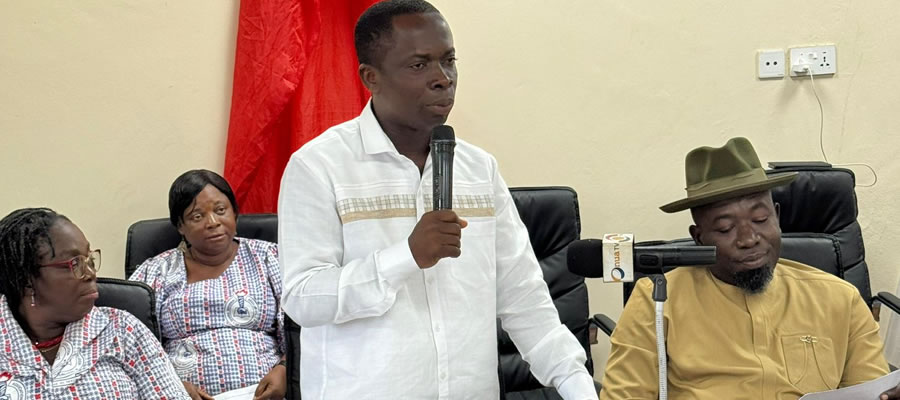

Basic Population Statistics
According to the 2010 Population and Housing Census (PHC), the total population of the district is 55,131 and projected to reach 65,514 in 2014 and consist of 49.6% males and 50.4% female with an inter censal growth rate of 3.3%. The district has a total fertility rate of 3.6 births per woman, with a crude birth rate of 25.6. There are more females than males in the district with a sex ratio of 98.6 males to 100 females whilst the total age dependency ratio is 84.3. The percentage of Twifo Hemang Lower Denkyira District to the total population of Central Region is 2.5 percent.
The relatively high population growth rate is attributed to the fertile soils which support both food and cash crops like oil palm, cocoa, plantain, cassava and others, thereby attracting many migrant farmers into the District. This phenomenon of increasing population therefore calls for a serious attention on population control programmes as large family sizes are often counterproductive to economic growth and development efforts.
Age-Sex Structure
The district according to its demographic characteristics, exhibits an age structure typical of a growing population with a higher proportion of children younger than five years and decreasing at each successive higher age. The population under 15 accounts for as high as 41.9% of the district’s population which is higher than the Regional average of 39.5%. The district can therefore be said to have a youthful population suggesting that there are lots of potential workers to boost economic activities especially in the agricultural sector, hence, the role of the private informal sector which remains the dominant employment generating sector in the creation of employment cannot be overemphasized.
The pattern depicts more male babies 0-4 age group is born in the district than females however, the male population decreases swiftly than the female through all the cohorts except in 60-64 to 85+ age groups of females, giving an indication of a high rate of out migration among the male youth perhaps to pursue educational and job opportunities outside the district. This has grave consequences for agriculture production in the district as the young men stay outside the district till they reach the retiring age. Also, the population size has been affected by immigration and high fertility with high births among the youth. The high fertility rates of 3.6 suggest that there is low patronage of contraceptives and other family planning methods
Age Dependency Ratio
The age dependency ratio which measures the ratio of dependent population (population aged under 15 years and above 64 years) to population in the “working-age group” (population aged 15-64 years) is one of the key indicators of socio-economic development. Generally the ratio is high in developing regions of the world than developed regions, reflecting demographic experiences of the two regions. The district’s age-sex structure in Fig … shows a pattern of decreasing population as age increase from 0-4 to 85+ age groups implying lower dependency tendencies among the elderly. The highest proportion of the districts population is within 0-4, 5-9, 10-14 and 15-19 age groups which also have the highest child dependency ratio (84.3/100) in the district. The age-dependency ratio at the district is 84.3/100. The dependency ratio among rural (88.2/100) population are higher than that of urban (74.3/100). Similar pattern is observed with regards to child and old age dependency.
Age-group 0-14 years is 41.8 percent and 65 years and above is 3.9 percent of the total population. The child dependency ratio is 77.1, 68.8 in the urban areas and 80.3 in the rural areas. Old age dependency ratio is 7.2, and it is 5.5 and 7.9 in the urban and rural areas respectively.
Gender
Gender Profile
According to the 2010 PHC report, the district has a population of 55,131 made up of 27,370 (49.6 %) males and 27,761 (50.4 %). In 2000, the district had 54.6% of its population as females and 45.4% as males. This compared with 2010 PHC indicates a rising pattern of population among males but a domination of females in the District. Females like their male counterparts in the district have contributed and still contribute immensely to the socio-economic and political development of the district through services, trading and farming, constituting 48.5% and 51.5% respectively of the employed population. From the 2010 PHC report, almost all the same proportion of males 97.9 % and 97.3 % of females are employed whiles 2.7 % females and 2.1 percent of males are reported to be unemployed, compared 34.3 % female and 31.2 % males not economically active.
In terms of sex distribution of the economically active, there is slightly higher proportion of males 72.6 % than female (71.9%). Again, there are more males in the public (Government) sector (6.3%) than females (2.9 %). Moreover, the proportion of males in the private formal sector is more (4.8%) than that of females (1.9%). However, a larger proportion of females (94.8%) are in the private informal as compared to males (88.4%).
Politically and administratively, women continue to play active roles although they are in the minority. Out of the 25 Assembly members, only five (5) are females representing 20%. At the District Administration, women in leadership positions constitute about 15.0% of the senior officers. The gender distribution in leadership roles may seem skewed in favour of males; however the impact of women in all sectors of the local economy is tremendous and commendable.
In spite of the recognizable contributions stakeholders in the district are making toward gender sensitization among the populace; numerous issues have been identified as critical in making gender mainstreaming a challenge in the district. These include;
- Low involvement of women in the implementation of project in the district
- Low income among women in the district
- Low gender awareness
- Single parenthood among women
- Lack of employable skills
- Child neglect
- Teenage pregnancy
- Maltreatment and abuse of women and children
Rural – Urban Split (Population Size by Locality)
The rural – urban split indicates the population size by locality of residence in the district. The total population of the district as indicated by the 2010 PHC is 55,131 made up of 49.6% males and 50.4% females. The urban population is 26.9% whereas the rural population is 73.1%.
However, more than 48 percent of the male population is in the urban areas whereas 50.1 percent are in the rural areas. Additionally 51.6 percent of the female population is in the urban areas as compared to 49.9 percent in the rural areas.
Population by Settlements
The district is a typical rural district. There are over 90 communities in the district with only two ofh them statistically, according to the 2010 PHC can be described as urban and these are the district capital Hemang and Jukwa. Other larger communities include Wawase, Krobo, Mfuom and Ampenkro. Most of the communities are harmlets and farmsteads, usually with populations below 500 people. All the major settlements are located along the Cape Coast – Twifo Praso – Dunkwa trunk road.
Rural-Urban Split
The total population of the district as indicated in the 2010 PHC is 55,131 made up of 49.6% males and 50.4% females. However, more than 48% of the male population is in the urban areas whereas 50.1% are in the rural areas. Additionally 51.6% of the female population is in the urban areas as compared to 49.9% in the rural areas.
Date Created : 11/21/2017 7:12:08 AM









 facebook
facebook
 twitter
twitter
 Youtube
Youtube
 +233 593 831 280
+233 593 831 280 0800 430 430
0800 430 430 GPS: GE-231-4383
GPS: GE-231-4383 info@ghanadistricts.com
info@ghanadistricts.com Box GP1044, Accra, Ghana
Box GP1044, Accra, Ghana